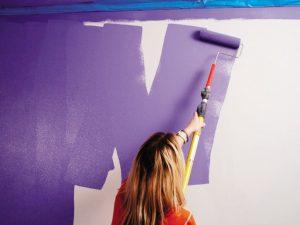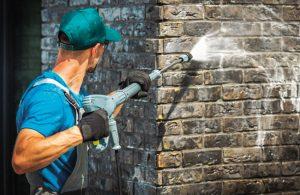 Paint allows you to create a space exactly to your liking. Not only can paint completely change the tone of a room, but it can also make a room appear bigger and brighter, depending on the color of the paint. All you have to do is grab a paint brush and some paint and go for it, right? Unfortunately, while it does seem like an easy task to take on, there are some important aspects to consider before starting to paint. The best tools and materials to utilize, the requirements of the surface or area you need to paint, the best way to paint, and knowing when to hire a professional are all things that should be taken into account before embarking on this project.
Paint allows you to create a space exactly to your liking. Not only can paint completely change the tone of a room, but it can also make a room appear bigger and brighter, depending on the color of the paint. All you have to do is grab a paint brush and some paint and go for it, right? Unfortunately, while it does seem like an easy task to take on, there are some important aspects to consider before starting to paint. The best tools and materials to utilize, the requirements of the surface or area you need to paint, the best way to paint, and knowing when to hire a professional are all things that should be taken into account before embarking on this project.
 Paint can easily get everywhere, and it’s not the easiest to get off flooring, especially carpet. Investing in a tarp or a plastic sheet to cover the floor in the room you’re working in will save you a lot of frustration down the line. If you do get paint on the floor, a wet wipe or paper towel can remove paint that’s not completely dry. If the paint has dried on a surface like tiling or wood, gently using a razor blade to scrape it off, while making sure not to scratch the floor in the process, should work well. Similarly, investing in the right tools to get the job done right is integral to having a well-painted area. Not only will you need a good quality paint brush, a roller, and a paint tray, but it would help (depending on the area that you are painting) to also get an extension pole, step stool, or a ladder. A nice trick for paint trays to save time on clean up afterwards is instead of putting the paint straight in the tray, use a disposable tray cover or cover it with a thin plastic bag. That way, the roller or brush can still get rid of excess paint, but you won’t have to spend as long washing paint out of the paint tray when you’re finished. Dried on paint can make brushes brittle and hard to use (or clean). Therefore, cleaning your brushes thoroughly with warm water and soap in between the times of use will be very useful and ensure that you get the most use out of the brushes.
Paint can easily get everywhere, and it’s not the easiest to get off flooring, especially carpet. Investing in a tarp or a plastic sheet to cover the floor in the room you’re working in will save you a lot of frustration down the line. If you do get paint on the floor, a wet wipe or paper towel can remove paint that’s not completely dry. If the paint has dried on a surface like tiling or wood, gently using a razor blade to scrape it off, while making sure not to scratch the floor in the process, should work well. Similarly, investing in the right tools to get the job done right is integral to having a well-painted area. Not only will you need a good quality paint brush, a roller, and a paint tray, but it would help (depending on the area that you are painting) to also get an extension pole, step stool, or a ladder. A nice trick for paint trays to save time on clean up afterwards is instead of putting the paint straight in the tray, use a disposable tray cover or cover it with a thin plastic bag. That way, the roller or brush can still get rid of excess paint, but you won’t have to spend as long washing paint out of the paint tray when you’re finished. Dried on paint can make brushes brittle and hard to use (or clean). Therefore, cleaning your brushes thoroughly with warm water and soap in between the times of use will be very useful and ensure that you get the most use out of the brushes.
 It’s equally important to get high quality paint. Better quality paint leads to fewer coats to get to a nice opacity and less streakiness. Fewer coats with better quality paint means less time spent painting and the quicker you can finish your project. It’s also important to keep in mind that the surface that you are painting helps determine which kind of paint you should use, as exterior paint is very different from interior paint. Exterior paint will have ingredients to not only withstand weather conditions but also to withstand different parts of nature, such as mildew and fungus. Exterior paints are not recommended for inside use, as additives such as mildewcides and fungicides can produce a smell in certain temperatures or levels of humidity.
It’s equally important to get high quality paint. Better quality paint leads to fewer coats to get to a nice opacity and less streakiness. Fewer coats with better quality paint means less time spent painting and the quicker you can finish your project. It’s also important to keep in mind that the surface that you are painting helps determine which kind of paint you should use, as exterior paint is very different from interior paint. Exterior paint will have ingredients to not only withstand weather conditions but also to withstand different parts of nature, such as mildew and fungus. Exterior paints are not recommended for inside use, as additives such as mildewcides and fungicides can produce a smell in certain temperatures or levels of humidity.
Something else to consider is the preparation that goes into painting. If you’re painting a smooth interior wall, there isn’t much preparation that needs to be done besides perhaps applying a primer to the wall before the paint, depending on your paint. On the other hand, if you plan on painting something like a brick wall, you will need to clean the brick first with soap, water, and a stiff brush. If the brick is on the outside of your house, a pressure wash will accomplish the same thing.
 The next portion after preparation is actually proceeding with the paint job. One of the first things to keep in mind is where to start and the painting order. If you are painting your trims, start with those working from the top down. It’s much easier to just tape off the trim once it’s painted than to have to tape off parts of the walls when you go to paint the trim. If you say to yourself, “I don’t need tape. I have a steady enough hand,” keep in mind that even professionals use tape. Not only is it a great way to ensure you don’t paint areas that should remain a different color or unpainted, but it also helps to create a crisp, even line. After the trim, move to the ceilings and then the walls working from the top down again.
The next portion after preparation is actually proceeding with the paint job. One of the first things to keep in mind is where to start and the painting order. If you are painting your trims, start with those working from the top down. It’s much easier to just tape off the trim once it’s painted than to have to tape off parts of the walls when you go to paint the trim. If you say to yourself, “I don’t need tape. I have a steady enough hand,” keep in mind that even professionals use tape. Not only is it a great way to ensure you don’t paint areas that should remain a different color or unpainted, but it also helps to create a crisp, even line. After the trim, move to the ceilings and then the walls working from the top down again.
Specifically with painting, it is important to go in with a steady and evenly-pressured hand and to let your tool do its job. For example, if you apply too much pressure on a roller, you are essentially just pushing the paint around instead of rolling it onto the surface evenly. Similarly, if you apply too much pressure to a brush, the bristles could leave marks in the paint that remain visible once the paint is dry. If you use a light and even hand while using a brush, your strokes will appear more level and uniform.
 Knowing your limits and when to call the professionals is very important when considering taking on a painting project. You won’t be able to fully enjoy your paint job if you accidentally end up hurting yourself in the process. If you come to realize that your ceilings are just too high to paint on your own or certain trims are too intricate and need a super steady hand, there are professionals that you can call. Even if it’s just that you don’t have the time to do the painting yourself in the timeline you want, that is what professionals are there for. Paint jobs can be very time intensive, so understanding how long it will take to complete what you’re trying to accomplish is important. In order to keep yourself from having multiple incomplete jobs, realistically thinking about how long your project(s) is/are going to take is imperative. If you’re on a tight schedule, it might be a good idea to contact a professional and see if they can complete the job in the timeframe you’re looking for. Unfortunately, sometimes when the length of a project is not considered, the end result can be disheartening, as it was rushed to get done rather than having enough time allotted for it to get completed to the fullest extent.
Knowing your limits and when to call the professionals is very important when considering taking on a painting project. You won’t be able to fully enjoy your paint job if you accidentally end up hurting yourself in the process. If you come to realize that your ceilings are just too high to paint on your own or certain trims are too intricate and need a super steady hand, there are professionals that you can call. Even if it’s just that you don’t have the time to do the painting yourself in the timeline you want, that is what professionals are there for. Paint jobs can be very time intensive, so understanding how long it will take to complete what you’re trying to accomplish is important. In order to keep yourself from having multiple incomplete jobs, realistically thinking about how long your project(s) is/are going to take is imperative. If you’re on a tight schedule, it might be a good idea to contact a professional and see if they can complete the job in the timeframe you’re looking for. Unfortunately, sometimes when the length of a project is not considered, the end result can be disheartening, as it was rushed to get done rather than having enough time allotted for it to get completed to the fullest extent.
 Paint can be transformative to any area. It can help you and anyone else in your household create the exact look you want to achieve. For example, it can help kids express themselves in their rooms, offer a brighter look to a room that is just a little too dark, or help a house stand out from others on the block. Being properly prepared for your paint project is very important because it will help with the longevity of your paint job as well as how good the paint looks when everything is completely finished. I hope these tips and ideas have helped you form a plan to realize your goals.
Paint can be transformative to any area. It can help you and anyone else in your household create the exact look you want to achieve. For example, it can help kids express themselves in their rooms, offer a brighter look to a room that is just a little too dark, or help a house stand out from others on the block. Being properly prepared for your paint project is very important because it will help with the longevity of your paint job as well as how good the paint looks when everything is completely finished. I hope these tips and ideas have helped you form a plan to realize your goals. ![]()
Caroline Murkey
Home & Yard Magazine




